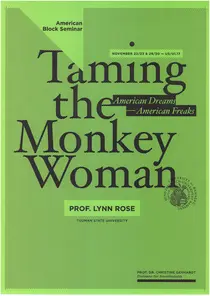Prof. Lynn Rose (Truman State University, USA)
"Taming the Monkey Woman: American Dreams/American Freaks" (November 2013)
Circus side-shows and dime museums exhibited more than their promise of amusement and enlightenment for the whole family. Bearded ladies and the fattest women ever, along with dog-faced boys, Siamese twins, and Australians, exhibited the limits and borders of acceptable appearance and behavior, and revealed shifting anxieties of a nation always in flux, which were addressed in this class. Who is Us? Who is Not-Us? Is "Us" superior to "Them"? The answer to the latter, of course, was a resounding yes.
Displays of human enfreakment had been established in Europe as didactic exhibits of divine wonder and error; imported to the United States, the amusements, embedded in traveling circuses in rural areas and dime museums in cities, wore a thin veil of illustrative education about strange humans and sub-humans from exotic, uncharted lands.
Freak shows, viewed through the interdisciplinary, liberationist field of disability studies, offer rich insights about human worth, gender boundaries, and behavioral limits. People with physical and other anomalies have always existed, but classification shifts over time and from one culture to the next. The meaning of disability, in other words, is relative to its context. The population of men with physical disabilities increased with the many amputations performed during the U.S. Civil War, but a quadruple-amputee Civil War veteran belonged to a completely different cultural category than, say, Freddy the Frogman, congenitally limbless, who performed circus acts such as rolling, lighting, and smoking a cigarette using only his mouth. War veterans, eventually, went into rehabilitation facilities specifically to return to their inherent normalcy--to become as standardized as possible; people displayed as freaks were exhibited as inherently abnormal beings.
Traveling circus freak shows had their heyday during the 1940s, and still in existed into the 1980s. Now, the freak show stage has been reappropriated by disability, genderqueer, and social justice activists, such as Jennifer Miller the Bearded Lady and her collaborators in Circus Amok. Still, human beings have not lost their desire to gawk at the outlandish and feel superior; the freak show continues, scholars argue, in cautionary tales and public displays of aberrational physical appearance and behavior (the Jerry Springer show, "Toddlers and Tiaras," and the Honey Boo Boo industry).
This seminar began with an introduction to freakery and freak shows within the conventional timeline of U.S. history, and then focused on eras of change that elicited high anxiety about race, class, gender, and ability. Finally, the course closely observed "triggers" such as the civil rights and disability rights movements; eugenics programs; exploration and the closing of frontiers; immigration; industrialization: statistical measurement and standardization; and hyperxenophobia.
The Instructor
Dr. Lynn Rose's specialties are ancient history and disability studies. Along with other publications, she has published one book, The Staff of Oedipus: Transforming Disability in Ancient Greece (University of Michigan Press, 2003). She was awarded a Mary E. Switzer Distinguished Fellowship for 2003-2004 to support her research project on intellectual disability in ancient Greece. She spent one year with the Institute for Greek and Latin Language and Literature at the University of Halle-Wittenberg and received a Fulbright scholarship for teaching one year at the University of Rostock. Dr. Rose, who was named Truman’s Educator of the Year in 2005, as well as the CASE (Carnegie) National Educator for Missouri in 2006, travels internationally whenever she has the chance. She is currently a professor at the Department of Social Sciences of the American University Iraq, where she teaches the history and humanities of the premodern world. (Homepage)
